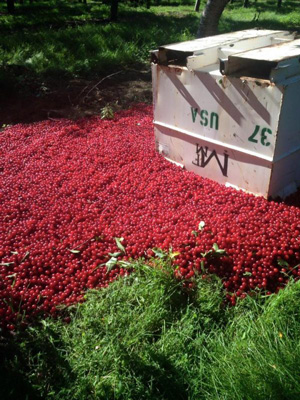
Loads of expensive cherries left to rot as USDA forces farmer to dump crop on the ground to make room for overseas imports
Amy Goodrch
(NaturalNews) Has the world gone mad? Recently, a Facebook post about expensive tart cherries being left to go rotten on the ground in Grand Traverse County has gone viral. A Michigan farmer, Marc Santucci, was forced to dump 14 percent of his crop to make room for 200 million pounds of cherries brought in from Turkey and Eastern Europe.
The post was shared over 65,000 times, and has sparked a lot of interest in how we are wasting fresh produce while so many people in the world go hungry.
Cherries are a unique fruit grown in only a few states across the U.S. Sweet cherries are mainly grown in Washington, California and Oregon, while most of the tart cherries are grown in Michigan.
Keeping prices stable
As reported by the Agricultural Marketing Resource Center, tart cherry production in 2014 totaled 300.9 million pounds valued at more than $106 million. However, crop yields vary significantly from year to year.
Therefore, the U.S. Department of Agriculture (USDA) has created a marketing order which puts a limit on the amount of tart cherries that can be sold by U.S. farmers to match the demand. The aim of the limit is to keep cherry prices stable for the growers.
Each year, the Cherry Industry Administrative Board (CIAB) determines the percentage of cherries that can be placed on the market. According to the Detroit Free Press, 2016 has been an excellent tart cherry year, with a surplus of 101 million pounds.
This resulted in Santucci being forced by law to dump 14 percent of his crop, even though he had found people who were willing to buy the cherries.

According to Santucci, the limitation on the number of cherries he can sell doesn't make any sense. He said that it is "a vain attempt to prop up the price of cherries." While U.S. farmers are forced to drop their beautiful product on the ground to limit the supply, overseas low-cost import of cherries has dramatically increased over the years – undercutting American growers and processors.
"If I have to sell these excess cherries for less, I might not make that much more," Santucci said. "But if we're ever going to stop the increase in imports, we've got to compete with them head to head on every cherry we produce. If we don't do that, we're leaving the market wide open to them."
A beautiful product gone to waste
No farmer wants to see his product rotting on the ground. There are some alternatives to dumping, such as donating or holding a stock of frozen or dried cherries for future years when there is a shortage. However, tart cherries are very delicate and spoil quickly. They must be processed and packaged within 24 hours.
To be able to donate cherries, farmers have to rely on a processor that is willing to spend his time and resources on processing the surplus. These processors are often too busy, leaving many cherry farmers with no other choice but to discard their product.
Food wastage is not a problem that only affects the cherry industry. As reported by Truth and Action, last year the Michigan Department of Agriculture forced the owners of the My Family Co-op to dump 248 gallons of fresh organic milk and destroy 1,200 eggs. Furthermore, they had to discard fresh cream, butter and cheese, after being accused of selling their products illegally.
According to Truth and Action, these laws and rules affecting small farms and co-ups are nothing more than government-backed actions from big agriculture companies to eliminate any form of honest competition and consolidate their food monopoly over the U.S. market.
If you want to learn more about the horrible practices of food regulators and food manufacturers, read Mike Adams' new book Food Forensics.
Sources for this article include:
http://www.naturalnews.com/z054984_crop_dumps_cherries_USDA.html